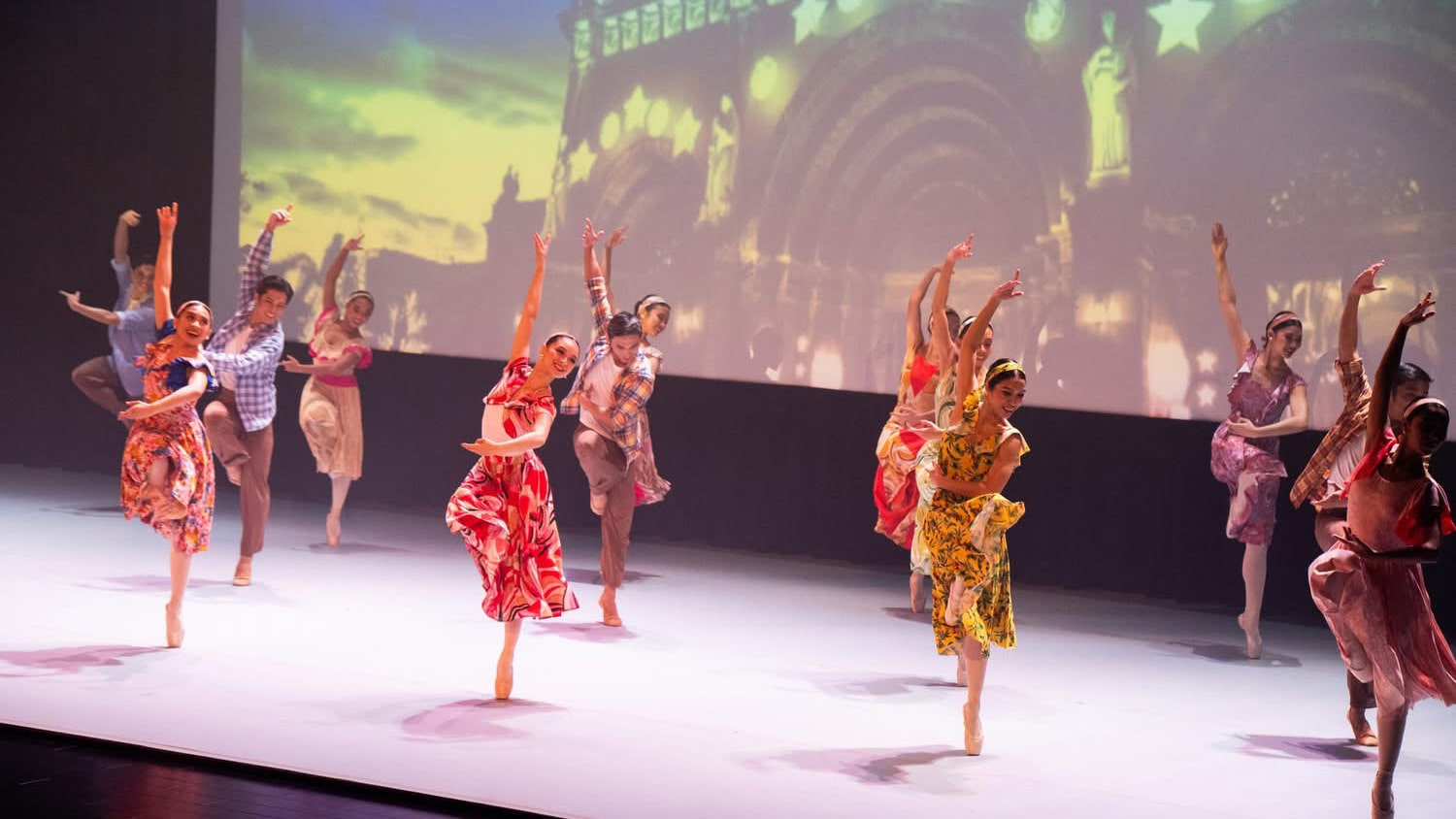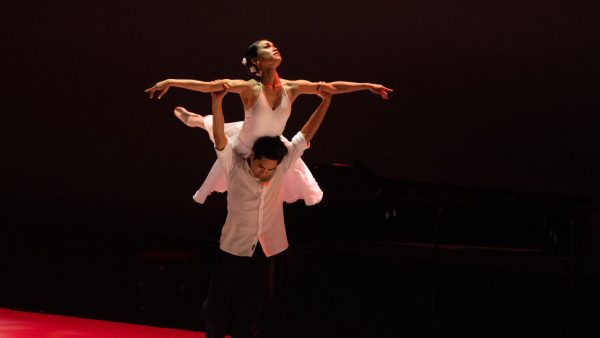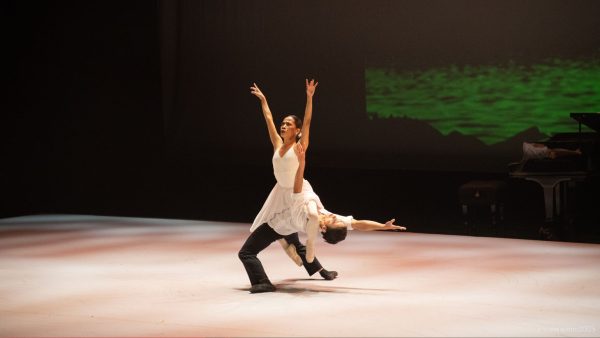
REVIEW: Acrobatic partnering ignites Philippine Ballet Theatre’s OPM showcase ‘Music in Motion’
Audiences were curious about the new Proscenium Theater at Rockwell, which hosted test runs ahead of its formal launch. Among the first to perform was Philippine Ballet Theatre (PBT) with its crowd-pleaser “Music in Motion,” a program of ballets set to Original Pilipino Music, much of it from film. For baby boomers who might doze off at “Swan Lake,” familiar tunes from their youth proved an instant lift. The bright costumes also delighted, though some color choices felt off. One audience member summed up the night’s acrobatic feats with an exclamation: “Ang galing ng Pinoy!”
The concert featured two suites: “On the Wings of Song,” set to Jose Mari Chan’s music, and “Serye at Sayaw,” eight ABS-CBN tracks from movies except for Ryan Cayabyab’s “Kay Ganda ng Ating Musika.” Both were choreographed by artistic director Ronilo Jaynario, giving more dancers a chance to shine.
Jarring Moments
Despite its popularity, “Music in Motion” showed cracks. The first suite dragged, its songs lacking a unifying theme. It opened with “Dec. 25,” a pre-holiday number that felt out of place in the typhoon season. The tone jarred with the love songs that followed. A French track, “Sous La Pluie de Paris (Under the Rain of Paris),” puzzled in a program celebrating Filipino music. Expectations for Tony Fabella’s beloved “Beautiful Girls” also fell flat. Fabella’s original spark—marked by musicality and movements crafted for the ballerinas’ personalities—was replaced by a different version. It was a six-minute pattern of arm flourishes, high kicks, fluttering skirts and cutesy smiles that sank under its own sweetness.
Jaynario’s choreography leaned heavily on acrobatic ballet: wrap lifts, split lifts, floor slides and horizontal catches—all visually striking. Yet the style often clashed with the emotional core of the songs. These high-energy moves, better suited to themes of abandon and passion, sat uneasily with tender ballads and unrequited love.
One jarring moment came with Jose Mari Chan’s “Can We Stop and Talk a While,” danced by Gabrielle “Gabbie” Jaynario and Matthew Davo. Both have matured in this piece, showing greater fluidity and range. Davo, now a steadier partner, kept Gabbie upright and centered in the supported pirouettes. Yet the choreography leaned too heavily on acrobatics, steps usually used to express unrestrained emotion, at odds with a song about a mid-20th-century young man shyly hoping to know a girl better.
The lyrics’ tentative first encounter, set in a crowded place, immediately triggered a supported multiple pirouette—an image in narrative ballet best reserved for emotional intimacy. Soon after, Davo dragged Gabbie across the floor, a brief but unflattering move that evoked the disposal of a tokhang victim, though not through any fault of the dancers. Later, Gabbie jumped to drape herself around him, a gesture of surrender, even as the lyrics described only the first sparks of attraction. Perhaps the most awkward moment came when she was lowered to crawl between his legs, suggesting overfamiliarity and a loss of inhibitions. When the line “It’s the first day of the rest of your life” played, the staging left us uncertain of its intent. Even so, the choreography itself showed promise, perhaps better suited to instrumental accompaniment
More Acro Partnering
The second half drew more eye rolls from balletomanes but awe from the rest of the audience, especially with George Canseco’s “Hanggang sa Dulo ng Walang Hanggan,” a ballad of unconditional love. Jessa Tangalin, Dominador Delmo, and Matthew Davo danced with athletic ease, eliciting gasps as the men fought for her affection through overhead tosses and flipping tosses. But the story got lost. The lyrics tell of a man who loves a woman even if she loves another, yet the choreography never made clear which man bore that heartbreak.

Jessa Tangalin and Matthew Davo in “Serye at Sayaw”; Erica Feliz Marquez-Jacinto
Still, Tangalin’s strength and artistic intelligence gave Jaynario’s choreography what emotional grounding it had. She shone brightest in “Sous La Pluie de Paris,” an outlier in the all-Filipino program. The dance itself offered little suggestion of how Parisian rain might bring hope, relying once again on tricks. But with Delmo, their seamless acrobatic partnering and innate musicality transformed a technical display into art—the kind that makes audiences forget the choreography and simply feel.
Two male solos stood out for the dancers’ projection. Ace Polias brought simple grace to “Perhaps Love,” while Justine Orande delivered “Anong Nangyari” with lyrical phrasing and crystalline precision. An often-overlooked pairing, Julafer Fegarido and Gladys Baybayan, won the audience with their heartfelt commitment in “Kailangan Kita.” Their movement breathed with the song’s phrasing, though the choreographer again could not resist inserting acrobatics. Baybayan draped her leg over Fegarido’s shoulder as he bent deep to the floor, then vaulted into a seamless overhead lift via a cartwheel mount. Fegarido’s partnering strength anchored the spectacle.
Davo was at his peak, unleashing suspended leaps, smooth turns and assured lifts. And if PBT held a beauty contest, Gabbie Jaynario—with her long neck, elegant lines and luminous presence—would take the crown.
Cultural Icon
The highlight of the evening was undeniably concert pianist Raul Sunico’s performance, even though his numbers were not listed in the program. His world-class artistry made us momentarily forget that the dance company was struggling to meet a respectable standard. Sunico’s playing moved the audience deeply, especially with his command of dynamics—from the softest pianissimo to the most powerful fortissimo—all delivered with complete mastery of tone and color.
This control brought out profound drama and emotion in the ballads “Sa Dulo ng Walang Hanggan” and “Kastilyong Buhangin.” His articulation was just as remarkable; every note had a distinct attack and release, shaping phrases that revealed the music’s true character.

Gladys Baybayan and Julafer Fegarido in “Serye at Sayaw”; Photo Credit: Erica Feliz Marquez-Jacinto
The “My Fair Lady Suite” showcased his virtuosity, with lightning-fast passages sweeping across the entire keyboard, each note precise and even. His cross-hand technique, with hands weaving and intertwining across the keys, added a dramatic visual flourish that drew appreciative gasps from the audience.
However, the production’s most puzzling oversight involved Sunico. A cultural icon whose presence lent the program weight, he was placed upstage near the back wall, obscured by the dancers instead of setting his piano downstage, closer to the audience. In the finale, “Kay Ganda ng Ating Musika,” repetitive choreography unfolded downstage while Sunico, reduced to a shadowy accompanist, was drowned out by the music.
As for the new Proscenium Theater, its 780 seats offer generous sightlines and bright acoustics. But the evening revealed teething problems by its crew. Companies were given the venue free, with limited setup time, and it showed. The stage felt shallow for a company of PBT’s size. Technical rehearsals were billed as “preview” quality, yet the sound was overly loud and the lighting lacked cohesion. Intelligent fixtures darted nervously, lighting transitions were abrupt, and dancers’ faces were often lost in shadow, undercutting the mood of such playful numbers as “Ang Nobya Kong Seksi.” Patterns projected on the floor during Sunico’s playing distracted from his performance entirely.
Ultimately, the evening served as a reminder that the PBT dancers, diligent and eager, deserve the kind of visionary direction that would let their hard work flourish as brightly as the Sunico’s performance.


Comments